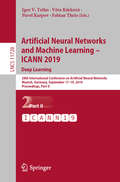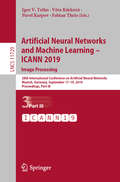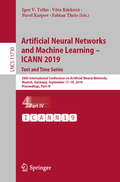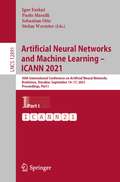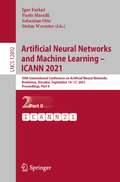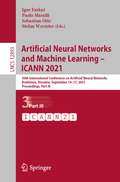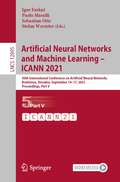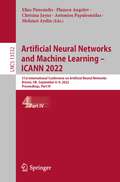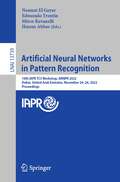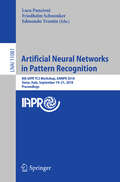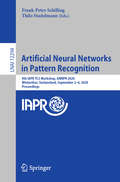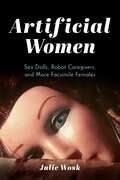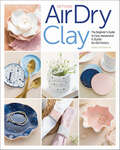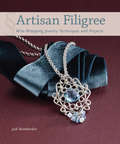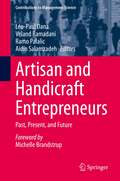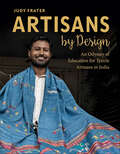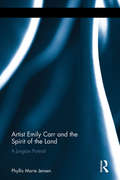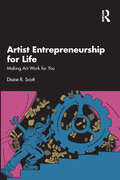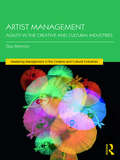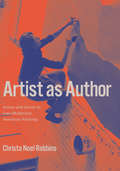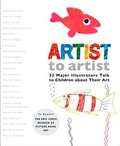- Table View
- List View
Artificial Neural Networks and Machine Learning – ICANN 2019: 28th International Conference on Artificial Neural Networks, Munich, Germany, September 17–19, 2019, Proceedings, Part II (Lecture Notes in Computer Science #11728)
by Věra Kůrková Fabian Theis Igor V. Tetko Pavel KarpovThe proceedings set LNCS 11727, 11728, 11729, 11730, and 11731 constitute the proceedings of the 28th International Conference on Artificial Neural Networks, ICANN 2019, held in Munich, Germany, in September 2019. The total of 277 full papers and 43 short papers presented in these proceedings was carefully reviewed and selected from 494 submissions. They were organized in 5 volumes focusing on theoretical neural computation; deep learning; image processing; text and time series; and workshop and special sessions.
Artificial Neural Networks and Machine Learning – ICANN 2019: 28th International Conference on Artificial Neural Networks, Munich, Germany, September 17–19, 2019, Proceedings, Part III (Lecture Notes in Computer Science #11729)
by Věra Kůrková Fabian Theis Igor V. Tetko Pavel KarpovThe proceedings set LNCS 11727, 11728, 11729, 11730, and 11731 constitute the proceedings of the 28th International Conference on Artificial Neural Networks, ICANN 2019, held in Munich, Germany, in September 2019. The total of 277 full papers and 43 short papers presented in these proceedings was carefully reviewed and selected from 494 submissions. They were organized in 5 volumes focusing on theoretical neural computation; deep learning; image processing; text and time series; and workshop and special sessions.
Artificial Neural Networks and Machine Learning – ICANN 2019: 28th International Conference on Artificial Neural Networks, Munich, Germany, September 17–19, 2019, Proceedings, Part IV (Lecture Notes in Computer Science #11730)
by Věra Kůrková Fabian Theis Igor V. Tetko Pavel KarpovThe proceedings set LNCS 11727, 11728, 11729, 11730, and 11731 constitute the proceedings of the 28th International Conference on Artificial Neural Networks, ICANN 2019, held in Munich, Germany, in September 2019. The total of 277 full papers and 43 short papers presented in these proceedings was carefully reviewed and selected from 494 submissions. They were organized in 5 volumes focusing on theoretical neural computation; deep learning; image processing; text and time series; and workshop and special sessions.
Artificial Neural Networks and Machine Learning – ICANN 2021: 30th International Conference on Artificial Neural Networks, Bratislava, Slovakia, September 14–17, 2021, Proceedings, Part I (Lecture Notes in Computer Science #12891)
by Paolo Masulli Stefan Wermter Igor Farkaš Sebastian OtteThe proceedings set LNCS 12891, LNCS 12892, LNCS 12893, LNCS 12894 and LNCS 12895 constitute the proceedings of the 30th International Conference on Artificial Neural Networks, ICANN 2021, held in Bratislava, Slovakia, in September 2021.* The total of 265 full papers presented in these proceedings was carefully reviewed and selected from 496 submissions, and organized in 5 volumes.In this volume, the papers focus on topics such as adversarial machine learning, anomaly detection, attention and transformers, audio and multimodal applications, bioinformatics and biosignal analysis, capsule networks and cognitive models. *The conference was held online 2021 due to the COVID-19 pandemic.
Artificial Neural Networks and Machine Learning – ICANN 2021: 30th International Conference on Artificial Neural Networks, Bratislava, Slovakia, September 14–17, 2021, Proceedings, Part II (Lecture Notes in Computer Science #12892)
by Paolo Masulli Stefan Wermter Igor Farkaš Sebastian OtteThe proceedings set LNCS 12891, LNCS 12892, LNCS 12893, LNCS 12894 and LNCS 12895 constitute the proceedings of the 30th International Conference on Artificial Neural Networks, ICANN 2021, held in Bratislava, Slovakia, in September 2021.* The total of 265 full papers presented in these proceedings was carefully reviewed and selected from 496 submissions, and organized in 5 volumes.In this volume, the papers focus on topics such as computer vision and object detection, convolutional neural networks and kernel methods, deep learning and optimization, distributed and continual learning, explainable methods, few-shot learning and generative adversarial networks. *The conference was held online 2021 due to the COVID-19 pandemic.
Artificial Neural Networks and Machine Learning – ICANN 2021: 30th International Conference on Artificial Neural Networks, Bratislava, Slovakia, September 14–17, 2021, Proceedings, Part III (Lecture Notes in Computer Science #12893)
by Paolo Masulli Stefan Wermter Igor Farkaš Sebastian OtteThe proceedings set LNCS 12891, LNCS 12892, LNCS 12893, LNCS 12894 and LNCS 12895 constitute the proceedings of the 30th International Conference on Artificial Neural Networks, ICANN 2021, held in Bratislava, Slovakia, in September 2021.* The total of 265 full papers presented in these proceedings was carefully reviewed and selected from 496 submissions, and organized in 5 volumes.In this volume, the papers focus on topics such as generative neural networks, graph neural networks, hierarchical and ensemble models, human pose estimation, image processing, image segmentation, knowledge distillation, and medical image processing. *The conference was held online 2021 due to the COVID-19 pandemic.
Artificial Neural Networks and Machine Learning – ICANN 2021: 30th International Conference on Artificial Neural Networks, Bratislava, Slovakia, September 14–17, 2021, Proceedings, Part V (Lecture Notes in Computer Science #12895)
by Paolo Masulli Stefan Wermter Igor Farkaš Sebastian OtteThe proceedings set LNCS 12891, LNCS 12892, LNCS 12893, LNCS 12894 and LNCS 12895 constitute the proceedings of the 30th International Conference on Artificial Neural Networks, ICANN 2021, held in Bratislava, Slovakia, in September 2021.* The total of 265 full papers presented in these proceedings was carefully reviewed and selected from 496 submissions, and organized in 5 volumes.In this volume, the papers focus on topics such as representation learning, reservoir computing, semi- and unsupervised learning, spiking neural networks, text understanding, transfers and meta learning, and video processing. *The conference was held online 2021 due to the COVID-19 pandemic.
Artificial Neural Networks and Machine Learning – ICANN 2022: 31st International Conference on Artificial Neural Networks, Bristol, UK, September 6–9, 2022, Proceedings; Part IV (Lecture Notes in Computer Science #13532)
by Plamen Angelov Elias Pimenidis Chrisina Jayne Antonios Papaleonidas Mehmet AydinThe 4-volumes set of LNCS 13529, 13530, 13531, and 13532 constitutes the proceedings of the 31st International Conference on Artificial Neural Networks, ICANN 2022, held in Bristol, UK, in September 2022. The total of 255 full papers presented in these proceedings was carefully reviewed and selected from 561 submissions. ICANN 2022 is a dual-track conference featuring tracks in brain inspired computing and machine learning and artificial neural networks, with strong cross-disciplinary interactions and applications.
Artificial Neural Networks in Pattern Recognition: 10th IAPR TC3 Workshop, ANNPR 2022, Dubai, United Arab Emirates, November 24–26, 2022, Proceedings (Lecture Notes in Computer Science #13739)
by Neamat El Gayar Edmondo Trentin Mirco Ravanelli Hazem AbbasThis book constitutes the refereed proceedings of the 10th IAPR TC3 International Workshop on Artificial Neural Networks in Pattern Recognition, ANNPR 2022, held in Dubai, UAE, in November 2022. The 16 revised full papers presented were carefully reviewed and selected from 24 submissions. The conference presents papers on subject such as pattern recognition and machine learning based on artificial neural networks.
Artificial Neural Networks in Pattern Recognition: 8th Iapr Tc3 Workshop, Annpr 2018, Siena, Italy, September 19-21, 2018, Proceedings (Lecture Notes in Computer Science #11081)
by Friedhelm Schwenker Edmondo Trentin Luca PancioniThis book constitutes the refereed proceedings of the 8th IAPR TC3 International Workshop on Artificial Neural Networks in Pattern Recognition, ANNPR 2018, held in Siena, Italy, in September 2018.The 29 revised full papers presented together with 2 invited papers were carefully reviewed and selected from 35 submissions. The papers present and discuss the latest research in all areas of neural network- and machine learning-based pattern recognition. They are organized in two sections: learning algorithms and architectures, and applications. Chapter "Bounded Rational Decision-Making with Adaptive Neural Network Priors" is available open access under a Creative Commons Attribution 4.0 International License via link.springer.com.
Artificial Neural Networks in Pattern Recognition: 9th IAPR TC3 Workshop, ANNPR 2020, Winterthur, Switzerland, September 2–4, 2020, Proceedings (Lecture Notes in Computer Science #12294)
by Thilo Stadelmann Frank-Peter SchillingThis book constitutes the refereed proceedings of the 9th IAPR TC3 International Workshop on Artificial Neural Networks in Pattern Recognition, ANNPR 2020, held in Winterthur, Switzerland, in September 2020. The conference was held virtually due to the COVID-19 pandemic. The 22 revised full papers presented were carefully reviewed and selected from 34 submissions. The papers present and discuss the latest research in all areas of neural network-and machine learning-based pattern recognition. They are organized in two sections: learning algorithms and architectures, and applications.
Artificial Women: Sex Dolls, Robot Caregivers, and More Facsimile Females
by Julie WoskWhat distinguishes humanity from artificial beings? What do constructed creatures tell us about ourselves? From sex dolls to Siri, talking Barbies to robotic mothers, Artificial Women explores the ways in which today's simulated females—both real and fictional—reflect and expose our own ideas about gender and female identity. Join Julie Wosk as she probes the realm of compliant sex workers, nurturing caretakers, genial servants, and rebellious creations in film, television, literature, art, photography, and current developments in robotics. These modern-day Galateas must embrace their own synthetic nature while also striving for authenticity and autonomy, all the while foregrounding gender stereotypes and changing perceptions of women and their roles. They embody the paradoxes and tensions that continue to arise in our increasingly simulated world, where the lines between the real and the virtual only continue to blur. As these "artificial women" become ever more lifelike, so too do the questions they raise become more provocative, and more illuminating of our own conceptions and conventions. Artificial Women pushes the boundaries of gender, sexuality, and culture studies to consider new digital technologies, artificial intelligences, and burgeoning simulations.
Artillery Warfare, 1939–1945
by Simon Forty Jonathan Forty“From mountain warfare with guns on mules to V2 rockets and everything between makes it well worth a place on anyone’s reference shelf.” —Clash of SteelIt is said that artillery won the Second World War for the Allies—that Soviet guns wore down German forces on the Eastern Front, negating their superior tactics and fighting ability, and that the accuracy and intensity of the British and American artillery was a major reason for the success of Allied forces in North Africa from El Alamein, in Italy and Normandy, and played a vital role in the battles of 1944 and 1945. Yet the range of weapons used is often overlooked or taken for granted—which is why this highly illustrated history by Simon and Jonathan Forty is of such value. They stress the importance of artillery on every front and analyze how artillery equipment, training and tactical techniques developed during the conflict.The selection of wartime photographs—many from east European sources—and the extensive quotations from contemporary documents give a graphic impression of how the guns were used on all sides. The photographs emphasize the wide range of pieces employed as field, antiaircraft and antitank artillery without forgetting self-propelled guns, coastal and other heavyweights and the development of rockets. The authors offer a fascinating insight into the weapons that served in the artillery over seventy years ago.“Superbly illustrated, this is testament to the courage and skills of extraordinary men in the execution of their duty. An amazing book.” —Books Monthly
Artisan Air-Dry Clay: The Beginner's Guide to Easy, Inexpensive & Stylish No-Kiln Pottery
by Radka HostasovaNo Kiln? No Problem! Learn to make beautifully textured home décor accents with inexpensive air-dry clay! The process is easy, and the results are surprisingly stylish when you follow the tips, advice, and instruction from author and clay artist-designer Radka Hostasova. Aimed at absolute beginners—this book starts with an overview of the tools and materials needed to produce the best results. A comprehensive "Getting Started" chapter teaches essential home pottery techniques such as rolling slab, coiling, sculpting, and pinching. Also included are creative ideas for adding color with acrylic paint, watercolor, and metallics. At the book's heart are a range of beautiful projects, including trinket bowls, napkin rings, wall hangings, coasters, and others. Each lesson comes with a detailed reference photograph and easy-to-follow step-by-step instructions. Roll, coil, sculpt and carve air-dry clay to create beautiful projects Make modern and stylish projects such as coasters, trinket dishes, home décor accents, kid's projects, and more Use easy home pottery as a mode of relaxation and stress relief
Artisan Filigree: Wire-Wrapping Jewelry Techniques and Projects
by Jodi BombardierEnjoy a collection of 20+ beautiful wire projects! Inspired by the ironwork so prevalent in her native Tucson, Jodi Bombardier fashions her signature heavygauge wire frames into sinuous shapes, cold-joining them with fine wire to form open, lacy filigree patterns. Learn Jodi's techniques, including the correct ways to use tools, hold wire, and create shaped wire frames consistently and precisely. Create airy pieces that are still strong and stable enough to withstand daily wear. Build confidence in your wirework skills as projects increase in complexity. In addition to providing project instructions, Jodi demonstrates how her scrolled designs can be manipulated, joined, or rearranged to create endless variations limited only by the imagination.
Artisan and Handicraft Entrepreneurs: Past, Present, and Future (Contributions to Management Science)
by Léo-Paul Dana Veland Ramadani Ramo Palalic Aidin SalamzadehIn handicrafts and artisanal products, industry has witnessed both a technological shift and a renewed interest among customers, especially after the challenges and limitations of mass production became evident under the COVID-19 pandemic. This book portrays the worldwide development of this trend, the nature of entrepreneurship in these industries, and the unique challenges and opportunities that entrepreneurs face. The book shows how these businesses are gaining a resurgence due to customers preferring ethical, regional, and climate-friendly options to fulfill their needs. The chapters focus on artisan entrepreneurs' contribution to society by not only creating businesses, but also in terms of tourism development. The book reiterates that artisan entrepreneurs enable crucial cultural connections with tradition due to their affinity to a region, city, village, or community. Small business and entrepreneurship researchers as well as policymakers in the cultural sector would benefit from this book.
Artisans by Design: An Odyssey of Education for Textile Artisans in India
by Judy FraterA firsthand account of the development of Kala Raksha Vidhyalaya—the first design school for traditional artisans in India—and its evolution to present-day Somaiya Kala Vidya, with personal stories of its students, their work and the school's effect on their lives and India's cultural and economic development. Somaiya Kala Vidya was conceived as a place where textile artisans in the Kutch District—a rugged arid region of western India known for its rich craft traditions—could learn design, business, and management in hands-on ways that strengthened their traditional knowledge, explore ecological methods of creating, and discover ways to connect to contemporary markets while sustaining their cultural heritage. Artisans by Design presents intimate stories of more than 20 artisans (intertwined with the author's story), detailing how their education brought them personal fulfillment, increased social and economic status, and an understanding of sustainability. Readers will learn: • How Somaiya Kala Vidya and Kala Raksha Vidhyalaya affected the lives and work of artisan students, both individually and as part of the larger craft communities of the Kutch District • The challenges and triumphs of founding, running, and maintaining the school • How outside forces—societal, political, environmental, and cultural—profoundly impacted the school and each student • And more More than 200 color photographs of the artisans and their work bring you an intimate view of this unique institution and the lives and works of its graduates.
Artist Animal (Posthumanities #25)
by Steve BakerAnimals have always been compelling subjects for artists, but the rise of animal advocacy and posthumanist thought has prompted a reconsideration of the relationship between artist and animal. In this book, Steve Baker examines the work of contemporary artists who directly confront questions of animal life, treating animals not for their aesthetic qualities or as symbols of the human condition but rather as beings who actively share the world with humanity.The concerns of the artists presented in this book—Sue Coe, Eduardo Kac, Lucy Kimbell, Catherine Chalmers, Olly and Suzi, Angela Singer, Catherine Bell, and others—range widely, from the ecological to the philosophical and from those engaging with the modification of animal bodies to those seeking to further the cause of animal rights. Drawing on extensive interviews he conducted with the artists under consideration, Baker explores the vital contribution that contemporary art can make to a broader conception of animal life, emphasizing the importance of creativity and trust in both the making and understanding of these artworks.Throughout, Baker is attentive to issues of practice, form, and medium. He asks, for example, whether the animal itself could be said to be the medium in which these artists are working, and he highlights the tensions between creative practice and certain kinds of ethical demands or expectations. Featuring full-color, vivid examples of their work, Artist Animal situates contemporary artists within the wider project of thinking beyond the human, asserting art&’s power to open up new ways of thinking about animals.
Artist Emily Carr and the Spirit of the Land: A Jungian Portrait
by Phyllis Marie JensenEmily Carr, often called Canada’s Van Gogh, was a post-impressionist explorer, artist and writer. In Artist Emily Carr and the Spirit of the Land Phyllis Marie Jensen draws on analytical psychology and the theories of feminism and social constructionism for insights into Carr’s life in the late Victorian period and early twentieth century. Presented in two parts, the book introduces Carr’s émigré English family and childhood on the "edge of nowhere" and her art education in San Francisco, London and Paris. Travels in the wilderness introduced her to the totem art of the Pacific Northwest coast at a time Aboriginal art was undervalued and believed to be disappearing. Carr vowed to document it before turning to spirited landscapes of forest, sea and sky. The second part of the book presents a Jungian portrait of Carr, including typology, psychological complexes, and archetypal features of personality. An examination the individuation process and Carr’s embracement of transcendental philosophy reveals the richness of her personality and artistic genius. Artist Emily Carr and the Spirit of the Land provides captivating reading for analytical psychologists, academics and students of Jungian studies, art history, health, gender and women’s studies.
Artist Entrepreneurship for Life: Making Art Work for You
by Diane R. ScottHolistically addressing the documented needs of practicing artists, this book applies contemporary business management principles to the unique circumstances of people who make their living through creative expression.Artists looking to forge a career have had to turn to either entrepreneurship resources or professional practice tools specific to a discipline such as studio arts or theatre—but the business-school entrepreneurial approach conflicts with the way artists make work and the unique structures of the artist environment, while the professional practice focus neglects the necessary business theory and the wide range of ways artists create viable careers. For the first time, this book provides a comprehensive theoretical and practical foundation for understanding how artists create practices that endure. Employing a strategic management framework, the book spells out prevailing business strategies in marketing, finance, human resources, and the legal environment from an arts-specific and artist-friendly point of view. In a world of perpetually changing communication, distribution, and technology, it also offers a lasting framework and understanding of the broader arts economy, while highlighting contemporary tools and tactics to implement the theories in individual practices.Practicing artists and students preparing for a career in any of the arts disciplines will welcome the artist’s perspective and the many examples from the lives of working artists in a variety of endeavors, while instructors in arts management, administration, and entrepreneurship will appreciate this comprehensive text with research-based pedagogy addressing their needs.
Artist Management: Agility in the Creative and Cultural Industries (Mastering Management in the Creative and Cultural Industries)
by Guy MorrowArtists are creative workers who drive growth in the creative and cultural industries. Managing artistic talent is a unique challenge, and this concise book introduces and analyses its key characteristics. Artist Management: Agility in the Creative and Cultural Industries makes a major contribution to our understanding of the creative and cultural industries, of artistic and managerial creativities, and of social and cultural change in this sector. The book undertakes an extensive exploration of the increasingly pivotal role of artist managers in the creative and cultural industries and argues that agile management strategies are useful in this context. This book provides a comprehensive and accessible account of the artist–artist manager relationship in the twenty-first century. Drawing from research interviews conducted with artist managers and self-managed artists in five cities (New York, London, Toronto, Sydney and Melbourne), this book makes an original contribution to knowledge. Nation-specific case studies are highlighted as a means of illuminating various thematic concerns. This unique book is a major piece of research and a valuable study aid for both undergraduate and postgraduate students of subjects including arts management, creative and cultural industries studies, arts entrepreneurship, business and management studies and media and communications.
Artist as Author: Action and Intent in Late-Modernist American Painting
by Christa Noel RobbinsWith Artist as Author, Christa Noel Robbins provides the first extended study of authorship in mid-20th century abstract painting in the US. Taking a close look at this influential period of art history, Robbins describes how artists and critics used the medium of painting to advance their own claims about the role that they believed authorship should play in dictating the value, significance, and social impact of the art object. Robbins tracks the subject across two definitive periods: the “New York School” as it was consolidated in the 1950s and “Post Painterly Abstraction” in the 1960s. Through many deep dives into key artist archives, Robbins brings to the page the minds and voices of painters Arshile Gorky, Jack Tworkov, Helen Frankenthaler, Kenneth Noland, Sam Gilliam, and Agnes Martin along with those of critics such as Harold Rosenberg and Rosalind Krauss. While these are all important characters in the polemical histories of American modernism, this is the first time they are placed together in a single study and treated with equal measure, as peers participating in the shared late modernist moment.
Artist as Author: Action and Intent in Late-Modernist American Painting
by Christa Noel RobbinsWith Artist as Author, Christa Noel Robbins provides the first extended study of authorship in mid-20th century abstract painting in the US. Taking a close look at this influential period of art history, Robbins describes how artists and critics used the medium of painting to advance their own claims about the role that they believed authorship should play in dictating the value, significance, and social impact of the art object. Robbins tracks the subject across two definitive periods: the “New York School” as it was consolidated in the 1950s and “Post Painterly Abstraction” in the 1960s. Through many deep dives into key artist archives, Robbins brings to the page the minds and voices of painters Arshile Gorky, Jack Tworkov, Helen Frankenthaler, Kenneth Noland, Sam Gilliam, and Agnes Martin along with those of critics such as Harold Rosenberg and Rosalind Krauss. While these are all important characters in the polemical histories of American modernism, this is the first time they are placed together in a single study and treated with equal measure, as peers participating in the shared late modernist moment.
Artist by Accident: The Story of Frida Kahlo (Fountas & Pinnell Classroom, Guided Reading Grade 5)
by Joan NicholsTHE PATH TO ART How does someone grow up to become a great artist? Some artists might say it's destiny. Some might say it requires genius. For Frida Kahlo, it happened by accident. NIMAC-sourced textbook
Artist to Artist: 23 Major Illustrators Talk to Children about Their Art
by David Briggs Kiffin Steurer Patricia Lee Gaucil Courtney PalmerThis gorgeous collection of art (and the artists behind it) includes work by some of the world's most renowned children's book illustrators--Mitsumasa Anno, Quentin Blake, Ashley Bryan, Nancy Ekholm Burkert, Eric Carle, Tomie dePaola, Jane Dyer, Mordicai Gerstein, Robert Ingpen, Steven Kellogg, Leo Lionni, Petra Mathers, Wendell Minor, Barry Moser, Jerry Pinkney, Alice Provenson, Robert Sabuda, Matthew Reinhart, Maurice Sendak, Gennady Spirin, Chris Van Allsburg, Rosemary Wells, and Paul O. Zelinsky. It's a remarkable and beautiful anthology that features twenty-three of the most honored and beloved artists in children's literature, talking informally to children--sharing secrets about their art and how they began their adventures into illustration. An event book for the ages. Proceeds from the book will benefit the Eric Carle Museum of Picture Book Art in Amherst, MA.
